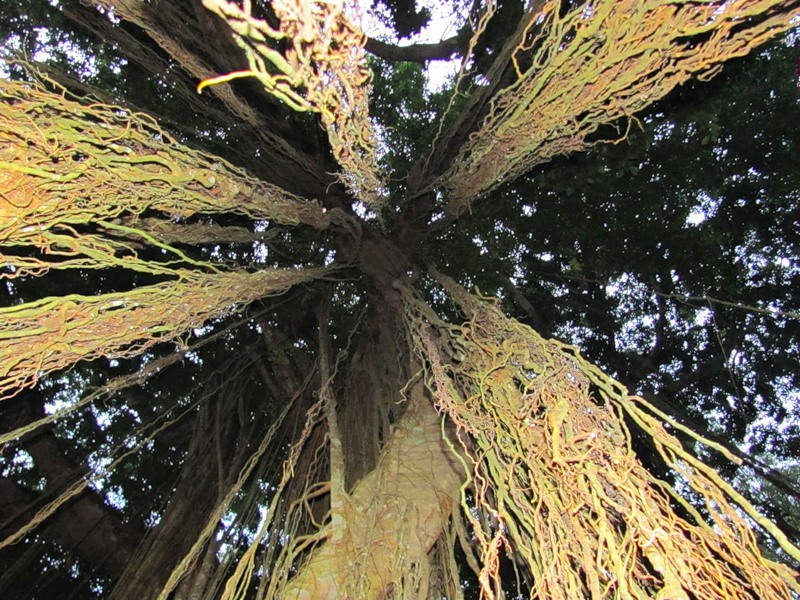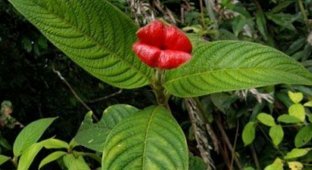Rubber-bearing ficus, or elastic ficus (lat. Ficus elastica) is a species of plant from the genus Ficus (lat. Ficus) of the Mulberry family.
The plant is native to northeast India (Assam) and south Indonesia (Sumatra and Java).

Ficus rubber is an evergreen tree reaching a height of 30-40 meters.
The leaves are alternate, oval with a sharp end, leathery, shiny, up to 20-30 cm long and 10-20 wide. Young leaves are pinkish-brownish in color, while old leaves are dark green.

The fruits are small, yellow-green, oval in shape, reaching 1 cm in diameter.
Ficus rubber is of industrial importance as a tree that produces rubber.

Ficus decorative, bonsai
Outside the tropics, the plant is grown as an ornamental indoor plant.

According to various sources, there are from 900 to 1000 species, distributed in tropical and subtropical regions. Among the life forms there are trees (with plank-shaped roots), shrubs, and vines.

"Ficus in Saigon."
Among the ficuses there are also “ficus stranglers”: at first these plants develop as epiphytes on other trees, where their seeds are carried by other animals.

"Ficus in Colombo."
But some time passes, the aerial roots of young ficus trees sink lower and lower, grow into the ground, thicken, entwine and squeeze the trunk of the host tree, which gradually dies.

Ficus bengal fruits
Another life form is named after the ficus bengal or banyan tree. It is also characteristic of the rubber plant in its natural environment. Aerial roots begin to develop on the horizontal branches of the tree. Growing into the ground, the roots thicken so much that they look like additional trunks. Over time, one plant forms a whole grove.

N. Verzilin in his book “Travel with House Plants” gives a description of the ficus given by Theophrastus, who accompanied A. the Great on his campaigns to India. “This is a mighty tree with a round crown and a monstrous diameter; it covers the space in two stages (300 meters) with its shadow.

Tree-grove
The circumference of the trunk is usually 40, and sometimes 60 steps; the leaves are equal in size and appearance to the shield. From the huge horizontally spread branches, roots descend annually into the soil, which differ from the branches only in their hard hair, paler color and lack of leaves: they themselves gradually turn into trunks and form, as it were, an artificially planted covered green passage around the main trunk.

"Ficus benjamina in Kandy."
A whole detachment of cavalry could camp under their shadow.”

Ficus benghalensis (lat. Ficus benghalensis) is a tree of the Mulberry family, growing in Bangladesh, India and Sri Lanka. As it grows, it can turn into a large tree, occupying several hectares, with a crown circumference of 610 meters in length.

The largest ficus bengal tree
This plant is characterized by a special life form - banyan. The formation of a banyan tree begins with the formation of aerial roots on large horizontal branches of an adult tree, which usually do not bear root hairs. At certain moments in the life of a tree, a lot of them appear, and they hang in garlands from horizontal branches.

"vegetation of Bali"
Aerial roots grow very slowly, and after a while most of them dry out without ever reaching the soil. Single aerial roots grow to the ground and take root, after which their above-ground part intensively thickens, acquiring the appearance and conducting function of trunks.

The Great Banyan tree is 200-250 years old and is the largest known banyan tree. The history of the tree, unfortunately, is not traced; there are only a few records dating back to the 19th century. During the hurricanes of 1884 and 1886, some of the main shoots were damaged and the tree was split into two parts. After a lightning strike in 1925, the main trunk split, as a result of which the trunk had to be cut out. After this, the banyan began to be considered a clonal colony, and not a single tree, as before.

Thanks to its large number of aerial roots, the Great Banyan looks more like a grove than an individual tree. There is a 330-meter-long path around the banyan tree, but the tree continues to grow beyond its boundaries. The crown of the tree has a circumference of about 350 meters, the greatest height reaches 25 meters. The tree area is approximately 1.5 hectares.
Currently, the Great Banyan tree has 2,880 aerial roots reaching to the ground.
Some types of ficus are capable of destroying rocks and buildings with their roots. But sometimes the roots and ruins of ancient buildings happily coexist, and then the work of human hands acquires special beauty and majesty. This can be observed, for example, in Cambodian Angkor Wat.


There are several hundred species of ficus in nature, but not all of them can be called banyans. This name is given to trees that develop numerous aerial roots, which subsequently become lignified and become additional trunks. The Bengal ficus almost always develops in this way, which is why its name has become synonymous with the banyan tree.

Since the Bengal banyan tree grows mainly in India, it has several names in Sanskrit. They describe certain features of an unusual tree. Nyagrodha – growing downwards (for the ability to send roots down), vata – to move, to surround (for the property of occupying large territories), bahupada – many-legged. But you can find gigantic trees not only in India, but also in any tropical forest - the main thing is that there is enough warmth and moisture.
A single banyan tree can form an entire grove, even a small forest, which shelters many birds, small animals (monkeys, lizards, snakes), and insects.

The banyan tree is considered a sacred tree in two religions - Buddhism and Hinduism. As you know, Buddha achieved the highest wisdom and gained enlightenment by meditating under this tree. In Hinduism, the banyan tree symbolizes the World Tree and is also associated with Brahman (Atman). The multi-legged tree is loved not only by Hindu sages, but also by women. Because it is a symbol of fertility and fertility.

First of all, because of the ability to survive and grow for many centuries, it is a symbol of eternal life, immortality, stability and inflexibility. The banyan descends to the ground (puts down aerial roots) and rushes to the sky (branches grow from the aboveground part of the rooted aerial roots), reproducing itself again and again (branches from the roots-trunks again release aerial roots, and so on). Hence the careful attitude towards banyan trees. It is believed that if the tree is harmed (cutting, pruning), this will arouse the wrath of the gods and a sacrifice will be required in atonement.

Under the banyan tree, Hindu sages meditated, seeking enlightenment, and held conversations and rituals. Hindus believe that ancient trees were themselves great sages in their previous lives.
The banyan tree also symbolizes fertility, fertility and brings children to the women who worship it.
On the full moon of the month of Jyeshtha (May, June) in India there is a special day - Vat Savitri Vrata - the day of honoring the banyan tree and the legendary Indian woman Savitri, whose love, devotion and wisdom allowed her to rise above death and fate and return life to her husband.

A banyan tree can live for several hundred years; it is believed that some of them grow even for several thousand years. Such centenarians could form up to 1,300 additional trunks, reach 30 meters in height, and the crown extended over a distance of up to 400 meters.

"The roots of Tetrameles-banyan"

“In the roots of the banyan tree. Ta Prohm Temple, Ankor, Cambodia"

"The Banyan Tree's Predatory Paw"
Ficus bridges
India is a country of mysteries, miracles and spiritual enlightenment. Local gods can boast of having a trunk and four arms, dogs have a third eye, and bridges grow by themselves.
One of them grew up in Cherrapunji, the wettest place on Earth. More precisely, a huge ficus grew, and the cunning locals thought of “stretching” the plant as a crossing over a mountain stream. The most surprising thing is that the unpretentious ficus has taken root on the other side of the rocky gorge.

However, local residents were not content with one bridge - they built another one, a little higher. Fortunately, the ficus root system allows you to do this. Ficus elastica is what scientists call this plant.

It is also unique in that the roots of the tree do not grow where all normal plants are supposed to - that is, underground, but the deeper it will have to be - they can break through the trunk. Botanists gave this phenomenon a special name - “secondary root system”.

The pioneer of root bridges is Denis P. Wright. He was so interested in unusual structures that he could spend hours talking about them to anyone who would listen to him, and even for some time organized special tours to India so that Europeans could appreciate the beauty of natural crossings.

To ensure that the ficus roots grow in the right direction, the residents of Cherrapunji use special scaffolding - hollowed out betel nut trunks. Thin, tender young roots grow along the beaten path, and when they reach the other side, they take root in the soil.

It takes about 10-15 years to “build” one such bridge, however, the final result is worth the time spent: the finished bridge can support up to fifty adults. Moreover, the older the bridge, the stronger it is - the roots become woody and become like strong steel cables.
























